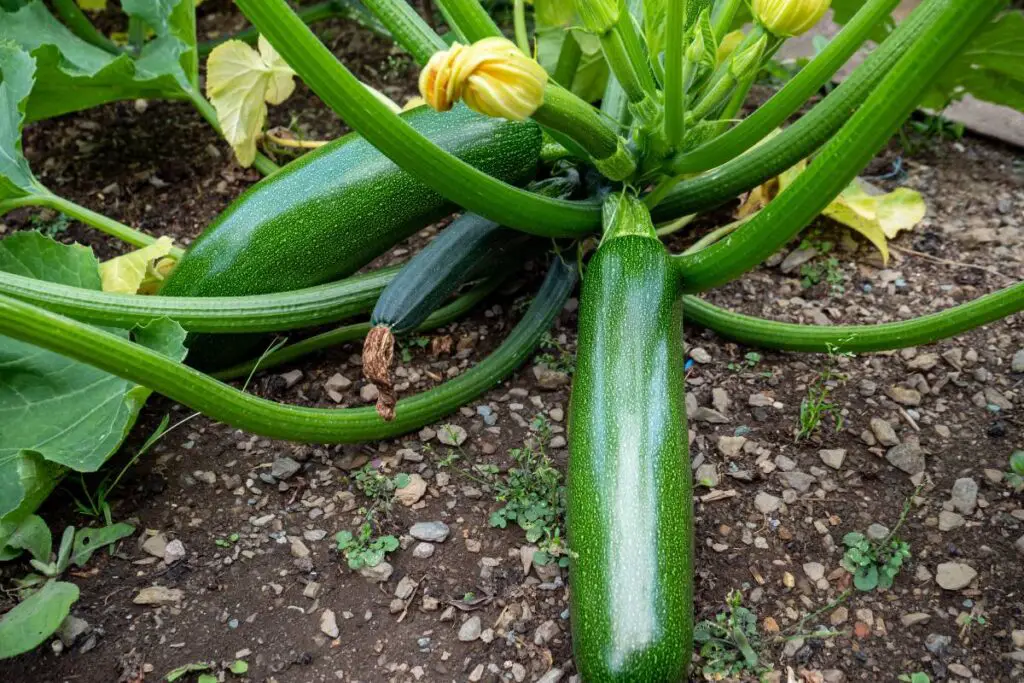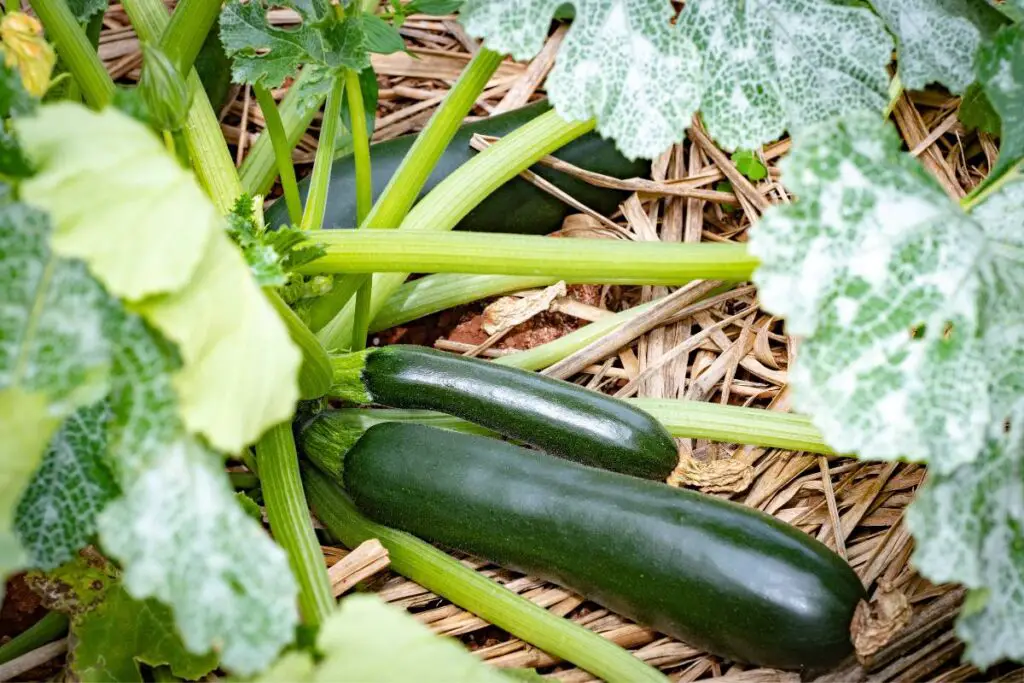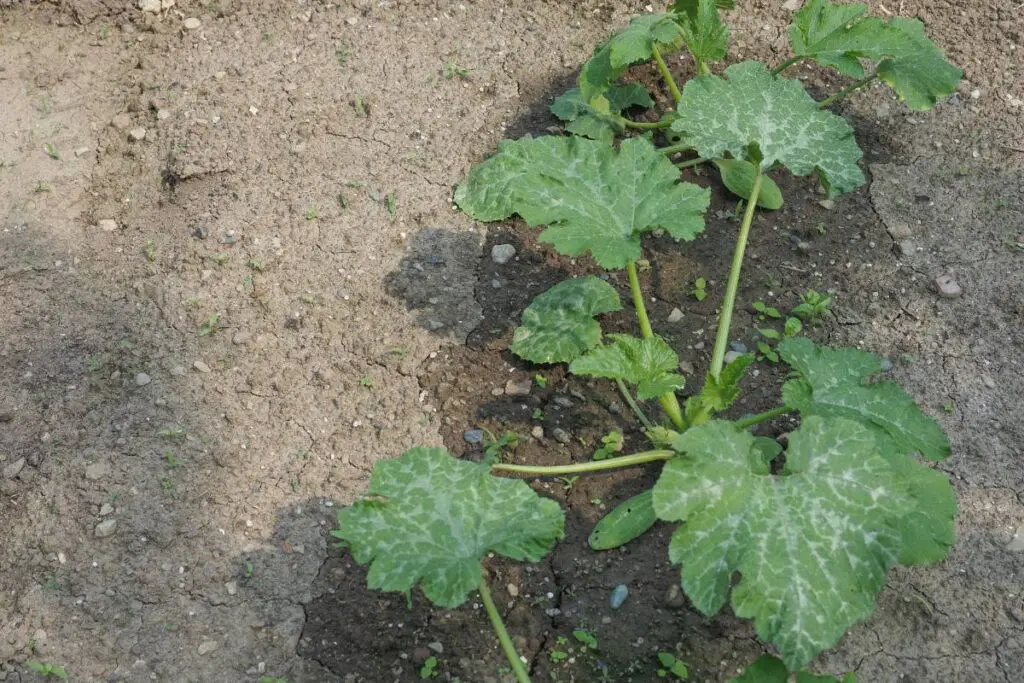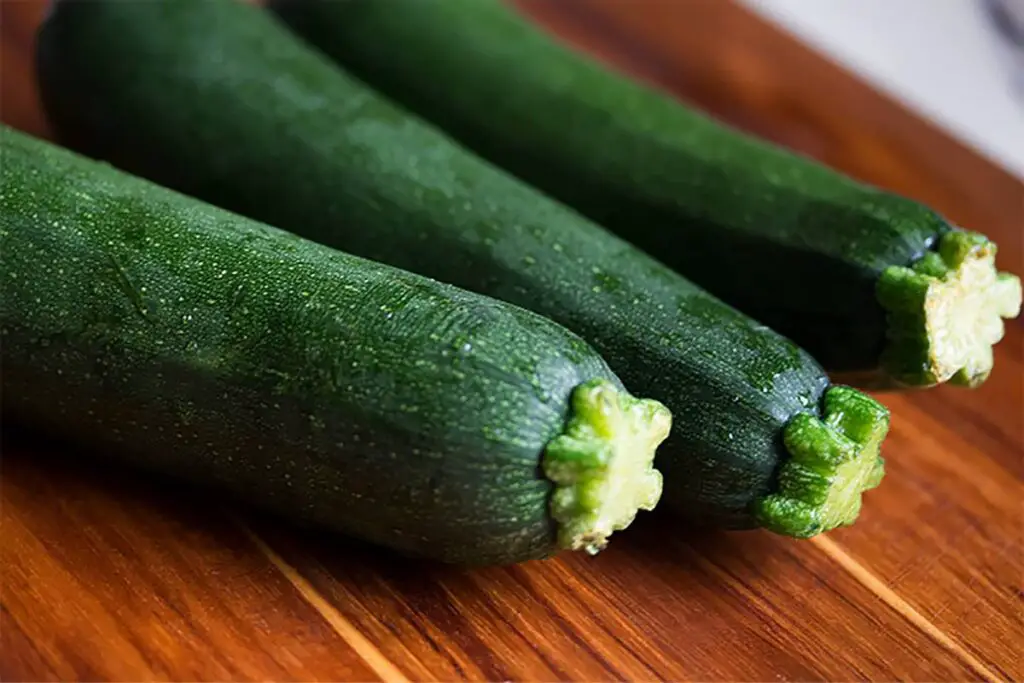Zucchini has been a loving summer squash for several years. The main attraction is their dark green fruits, fast growth, and vast production. But have you ever wondered how much one plant will produce? Let’s see.
One Zucchini plant can produce around 6-10 pounds of fruits. It means it can produce around 3-9 every week, provided you pick them when they are still immature and young. Since Zucchinis grow for 2-3 months, expect to receive 30-40 fruits per growing season.
You will get more if you have more than one plant. However, the number of fruits can depend on a few factors. In this article, I will share the factors that affect the yields, the average number of fruits per plant, and ways to improve the plant’s health and yield.

Understanding Zucchini Growth
Zucchini is a fast-growing summer squash plant.
Growing and producing lots of fruits can take around 45 to 55 days.
I have been growing Zucchini for a long time.
I was very excited to see the results, so I observed their every growth stage and speed.
I noticed that once the Zucchini starts blooming, the female flowers will start producing fruits from the base after some time of pollination.
After a few days, the tiny fruit grows into a mature plant.
This process takes only 4 to 8 days.
Since they are very fast growers, you can expect them to grow numerous fruits.
The plant can produce fruit very fast and in abundance.
The fruit size increases by one inch daily.
If you see a fruit to be 4 inches today, overnight, it turns into 5-6 inches. That’s how fast they are.
Why are Zucchinis fast growers?
If you have grown Zucchinis, you will know that Zucchinis can grow and produce faster. Their fruit size increases by one inch daily.
But have you ever wondered why they grow that much? Here are the reasons:
Easy to grow
Zucchini plants are low-maintenance plants and very easy to grow.
They are not as demanding as the other plants.
You can receive many fruits from one plant in one growing season with the proper requirements.
Provide adequate sunlight and moisture, grow them in soil mixed with organic matter, and encourage pollination.
Within 40-50 days, you will have abundant Zucchini growth.
Rapid growth
Zucchini plants are very fast growers by nature.
That is why they can produce many fruits with the proper care and environmental conditions.
The fruits can grow around 1-2 inches daily.
Within a few days after producing, the fruits get ready for harvest.
Cyclic production
Whenever you harvest a zucchini from your plant, a new one will grow in its place.
The plant can be produced constantly throughout the entire growing season.
You need to keep harvesting.
Otherwise, the production will reduce, and the fruits become overripe and bad to taste.
Factors Affecting Zucchini Yield

You know that Zucchini are fast growers, and the reason behind their fast growth.
However, several factors can affect the Zucchini yield.
These factors can either boost their yields or slow down their growth.
Let’s have a look at those factors:
Plant health
A healthy, disease-free, and bug-free plant will yield more than a weak plant suffering from diseases and bugs.
An unhealthy plant will have lower yields than a healthy one.
If your plant has been healthy throughout its growing journey, it will have higher yields.
Weather conditions
For adequate yields, the Zucchinis will need warm weather for 3 months.
If your living region receives a warm temperature of around 65 to 75°F for around 3 months, you will notice a higher yield in your plant.
But if your living zone is colder and you receive a shorter growing season, expect lesser yields.
Growing conditions: Sunlight, water, and soil
The plant requires good growing conditions for optimal growth.
Zucchinis need 6-8 hours of sunlight.
The more sunlight they receive, the better and higher their yields will be.
The same goes for the watering needs.
The soil needs to stay evenly moist all the time.
A plant with moist soil throughout the growing season will have more fruits than one suffering from overwatering, underwatering, or moisture fluctuations.
Zucchinis need well-drained and loamy soil with a pH of 6.5 to 7.
This type of soil promotes better growth and higher yields.
Adding organic matter to the soil before planting and considering regular fertilization after they begin vegetative growth will boost the plant’s growth and promote more production.
Looking for gardening supplies? We have tested 100's of products before recommending them to you guys. Check out our best pick below:
| Image | Gardening Supplies | Best Price? |
|---|---|---|
 Top
Top Top
Top | Raised Garden Bed Kit | Check On Amazon |
 | XLUX Soil Moisture Meter, Plant Water Monitor, Soil Hygrometer Sensor for Gardening, Farming, Indoor and Outdoor Plants, No Batteries Required | No Results |
 Top
Top Top
Top | 82 Pcs Garden Tools Set and Extra Succulent Tools Set | Check On Amazon |
 | Joeys Garden Expandable Garden Hose with 8 Function Hose Nozzle, Lightweight Anti-Kink Flexible Garden Hoses, Extra Strength Fabric with Double Latex Core, (50 FT, Black) | No Results |
 Top
Top Top
Top | Dual Chamber Compost Tumbler | Check On Amazon |
 Top
Top Top
Top | Sunnyglade Plant Stakes | Check On Amazon |
 Top
Top Top
Top | Organic Cold Pressed Neem Seed Oil | Check On Amazon |
 Top
Top Top
Top | Mighty Mint Gallon :-Insect and Pest Control Peppermint Oil | Check On Amazon |
 Top
Top Top
Top | Scotts DiseaseEx Lawn Fungicide | Check On Amazon |
 Top
Top Top
Top | Jacks Classic 20-20-20 All Purpose Fertilizer | Check On Amazon |
 Top
Top Top
Top | 30,000 Seeds Pollinator Attracting Wildflower Mixture | Check On Amazon |
 Top
Top Top
Top | Survival Vegetable Seeds Garden Kit-Over 16,000 Seeds | Check On Amazon |
Pollination
The more pollinators visit your garden and pollinate, the more fruits your plants will grow.
Zucchini plants require bees and butterflies for pollination.
The yield will be lower if these pollinators are unavailable in your garden.
However, individuals can step in for hand pollination and increase yields.
Variety
Different Zucchini varieties have different growth habits.
Some varieties may take a full 55 to 60 days to develop fruits, but some can have ready-to-harvest fruits within 42 to 45 days.
Average Yield per Zucchini Plant

Generally, one plant can produce around 30 to 40 Zucchinis in one growing season with the right growing conditions.
It will be around 6 to 10 pounds or 4 to 16 lbs of fruit per season.
For a weekly count, expect one plant to produce around 3 to 9 fruits per week.
But you must pick them small when they have reached 6 to 8 inches long. The more you pick, the more fruits you get.
You can expect 2-3 pounds of Zucchini from every harvest.
For a homegrown meal for one person, 200 gms of Zucchini, diced and cooked, will be enough.
Two small Zucchinis or a large one will be enough in that case.
A single plant can produce more than enough for one person.
If you are single, 1-2 plants would be enough.
If you are a family of 2-4, 4 to 8 plants would be enough.
According to Oklahoma State University, Zucchini yield per acre is around 8 tons per acre.
These are just average values.
The number can depend on growing conditions, weather, plant health, and variety.
Give your plant enough moisture, sunlight, and fertilizers for enough yields.
Varietal Differences
Different varieties will have different yields. But the difference is not much.
If you pick the Zucchinis when they are young and reach around 6 to 8 inches, the yield from every variety will be more or less the same.
Several Zucchini varieties are available, but some of the fastest varieties with many fruits are Black Beauty, Sunburst, and Costata Romanesco.
These can produce young and ready-to-pick Zucchinis for around 40 to 45 days.
The fruits can reach up to 6 to 8 inches long.
Here is a small list of different varieties and their yields:
- Green Bush: 18 lbs
- Summer Holiday: 15 lbs
- Black Beauty: 13 lbs
- Lemona: 13 lbs
- Eight Balls: 13 lbs
- Romanesco: 12 lbs
- Patty Pan: 10 lbs
- Sunstripe: 9 lbs
- Zephyr: 9 lbs
- Tromboncino: 7.5 lbs
This is just an average. The overall yield can vary.
How to improve Zucchini yield?
Are you not receiving the number of Zucchinis up to your expectations? Then, you must improve your Zucchini yield by taking good care of the plant.
There are several ways to improve the Zucchini yield. The primary method is to take good care of the plants and provide them with all their requirements for healthy growth.
Besides this, there are a few more things to do.
In this section, I will share some valuable tips to improve the yield of your Zucchini plant and receive lots of Zucchinis every growing season.
Plant Spacing and Placement
Zucchini plants will need plenty of space to grow.
They can grow well and produce enough fruits with proper space and air circulation.
Zucchini do not sprawl over the ground but have a spreading habit.
Maintain around 2-3 feet distance between them.
The more space they receive, the better they will grow and receive airflow, reducing the chances of mildew.
Make sure to sow the seeds around ½ to 1 inch deep into the soil.
Watering and Irrigation Practices

Watering is one of the most critical factors that help in Zucchini yields.
Zucchini has a hunger for moisture.
A hydrated plant produces more fruits than a dry plant. When you pick a Zucchini, it is pretty weighty.
It indicates the moisture content, which keeps the fruit tasty and fresh.
A Zucchini plant will need one inch of water every week. A best practice is to check the moisture level and then water the plant.
Insert your finger around 1-2 inches deep into the soil.
If it feels dry, you can water the plant; otherwise, wait more days.
You can water the plant base using a soaker hose or drip irrigation.
Sunlight and temperature
Just like watering, the Zucchinis are also hungry for sunlight.
They need 6 to 8 hours of sunlight and warm weather around 70-75°F.
Once the plant receives the correct sunlight and warm temperatures for around 2-3 months, you will find uncountable fruits from the plants.
The yield will be relatively higher than in the other seasons.
Along with the increase in the number of Zucchinis, adequate sunlight, water, and nutrients can also help in increasing the fruit size.
Soil Preparation and Fertilization
Another requirement that helps improve Zucchini yield is soil type and proper feeding.
Zucchinis will need loamy, well-drained soil with 6.5 to 7 pH levels.
To prepare the soil, dig a few inches of the topsoil and add some organic matter and a handful of organic fertilizer.
Mix them well and then sow the seed.
Use any seed starting mix in a germination tray or container to start the seeds indoors.
Once the plant starts growing and you want to keep it in the pot, take 50% of the soil and organic matter each.
Check our Zucchini Soil Requirement article for more recipes.
Once the plant reaches 6 to 8 inches tall and starts vegetative growth, use a balanced 10-10-10 liquid fertilizer throughout the season.
Follow our Zucchini Fertilizer article for detailed information.
Adequate fertilization will boost the plant growth and improve Zucchini yield.
Pruning and Plant Maintenance
Along with the fruit production, the vegetative growth will also be faster.
Over time, the plant will grow many large leaves that must be pruned.
Zucchini leaves are enormous.
The fruits can sometimes stay hidden behind it, and you may miss the harvest.
If you do not prune, the plant will overgrow and may not grow enough fruits.
Pruning will keep your plant healthy and allow the plant to focus on making more fruits.
Prune some lower leaves, outer leaves, and dead and damaged foliage.
Do not prune too much at a time, as that will stress the plant and reduce yield instead of improving it.
Pollination and Fruit Set

Pollination is one of the best ways to increase Zucchini yield.
The pollinators like bees, butterflies, and other insects will help pollinate by carrying the pollen from the male to the female flower.
If there has been a lack of pollinators, you will have lesser yields.
It mostly happens when the weather is rainy, or you live near water areas.
In that case, you need to hand-pollinate.
Using a brush or cotton swab, swab the pollen from the male flower and then rub it on the female flower.
It will increase the chances of pollination and improve yields.
Disease and Pest Management
Keep a close eye on pests and diseases, like yellow leaves, holes, defoliation, or spots.
Common pests that can attack the Zucchinis are squash bugs, cucumber beetles, and aphids.
Powdery mildew is commonly caused by high moisture or humidity and lack of airflow.
Solving these issues early can increase your plant’s lifespan and improve Zucchini yields.
Consider organic pest control methods to manage pests and diseases.
For pests, use insecticides like neem oil.
This will deter the bugs and prevent them from damaging your plant further.
It also works for mildew diseases.
To prevent infestation, keep your plant healthy.
Let it have enough sunlight and evenly moist soil (neither too moist nor too dry), and feed it in time.
If the plant is healthy, it can easily fight these problems and revive faster to improve your plant yield.
Mulching and Weed Control
Mulching can be helpful in many ways:
- It keeps the soil moist, reducing watering issues.
- Controls weed growth around the plant, preventing competition for resources.
- During the winter, mulching keeps the soil moist and prevents cold weather from reaching the roots.
Since mulching can aid the plant in many ways, it keeps it healthy and increases yield.
Succession Planting
For a continuous supply of Zucchini, consider succession planting.
Zucchinis are fast growers, but their production can reduce as they age.
So, consider succession planting for a constant supply of fruits.
Here, you will sow the Zucchini seeds every 2-3 weeks. For example, if you are sowing 5 seeds this week, again sow 5 more after 2 weeks.
Companion Planting
Companion planting can help improve the yield of the Zucchinis.
Some companions can keep the Zucchinis healthy and improve their yields.
For example, flowering plants like Sunflowers and Nasturtiums can attract pollinators.
Planting them with Zucchinis can improve the chances of pollination.
Herbs like Dill, Oregano, and Lavender can deter pests by their strange, strong smells.
Legumes can release nitrogen into the soil.
When Zucchinis grow beside them, they can benefit from it.
Nitrogen helps in the plant’s vegetative growth and makes the plant stronger.
It will be beneficial later when the plant blooms and produces flowers.
Harvesting Zucchinis timely
Regularly harvesting the Zucchinis can improve the yield.
You must have read about the cyclic production I have shared earlier.
Every time you harvest a Zucchini, another fruit will grow in its place.
Harvesting the Zucchinis frequently allows the plant to grow more fruits.
This way, you can improve the plant yield and receive many fruits throughout the growing season.
Preserving and Using Excess Zucchinis

If you have harvested too many Zucchinis, you can either store them for later use or share them with your friends and family.
There are three ways to store the Zucchinis:
Storing in the fridge
Zucchinis can ripen off the vine if kept at room temperature and humid and warm environment. So, store them in a dry and cool place.
Place the Zucchini in a paper bag with one end open for airflow and put it in the fridge’s crisper drawer.
It will keep the Zucchinis fresh for 1-2 weeks.
Please do not wash the fruits unless you intend to use them immediately.
Storing sliced Zucchinis
Suppose you have cut the Zucchinis and suddenly realize you have had too many of them. Storage is still possible.
Store these fruits in a crisper drawer in a tightly sealed container or a zip-lock bag for a week. After that, you must consume them.
Storing in the freezer
If you have a surplus amount of Zucchini, store them in the freezer for long-term storage.
Shred the Zucchinis with a grater.
Steam, cool, and pack them in a heavy-duty resealable bag in the freezer.
For sliced or spiralized Zucchinis, blanch them in hot water for a minute. Strain and let them dry.
Put them in the freezer on a backing sheet for 1-2 hours.
Take them out, put them in freezer-safe bags, and store them in the freezer.
You can store the Zucchini in the freezer for around 3 months.
Final Thoughts
Determining the number of Zucchinis one plant can produce depends on weather, growing conditions, variety, provided requirements, and many more.
Understand these variables to avoid too high or too low expectations. However, on average, one plant can produce around 3 to 9 fruit weekly.
So, expect around 30-40 fruits per season from one plant. The yield will vary based on the Zucchini variety. For example, Lemona can produce 13 lbs, whereas Zephyr produces 9 lbs per season.
If you are not getting enough yields, try improving it by providing the plant with adequate requirements.
Making an environment with adequate moisture levels, fertile and well-drained soil, taking advantage of the sunlight, and feeding the plant in time leads to optimal yields.
Besides these, pruning, ensuring pollination, succession, companion planting, mulching, and harvesting in time increases the yield. By the end of the season, you will have a surplus amount of Zucchinis.
You can share them or store them properly for future use. Throughout the journey, check for pests and diseases and troubleshoot them initially so they do not spread and kill the plant.
That would decrease yield to a great level. Whether a seasoned gardener or a beginner, a healthy plant is all you need for constant Zucchini production and higher yields.
Will Zucchini keep producing?
It depends on your region’s climate, growing conditions, and care. If everything seems favorable for the plant, it will keep producing throughout its growing season.
Why are the flowers from my Zucchini plant falling off?
Usually, the male flowers fall off after they run out of pollen. If that’s not the case, you have some others that must be addressed.
Reference: Zucchini Wikipedia

